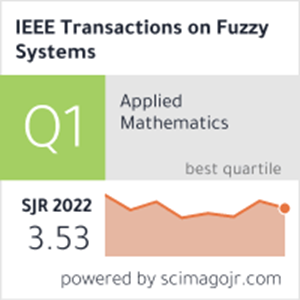图神经网络的动态模糊采样器
IF 11.9
1区 计算机科学
Q1 COMPUTER SCIENCE, ARTIFICIAL INTELLIGENCE
引用次数: 0
摘要
图神经网络(Graph Neural Networks, gnn)被广泛应用于各个领域,归纳学习以其优越的记忆效率、计算速度和泛化能力取代了传导学习成为主流的训练范式。邻居节点采样是归纳学习的关键步骤,对模型的性能至关重要。然而,现有的采样器只关注基于邻接矩阵的采样,忽略了不同邻居对目标节点随时间变化的影响。它们通常以平均或求和等简单的方式聚合邻居信息,这限制了信息的表示、鲁棒性和泛化。为了解决这些限制,我们提出了一种基于高斯模糊系统的动态模糊采样器(DFS)。DFS考虑了节点的多样性,对邻目标互信息的不确定性和模糊性进行了动态建模。具体而言,DFS首先创新地构建了一个可学习的高斯模糊集系统,用于确定不同时刻不同邻居对目标节点的隶属度。随后,DFS对目标节点嵌入和隶属度加权邻居嵌入进行聚合,更新目标节点的特征,使目标节点更有效地利用采样信息。聚合后的目标节点有效捕获了图的结构信息和相邻节点信息,有利于后续基于图神经网络的图表示模型具有更强的表示能力和泛化能力。在监督和自监督图数据集上的实验结果表明,DFS始终优于最先进的采样方案。与目前最先进的方案相比,DFS在小图和大图上的f1分数分别提高了1.90%和9.52%。本文章由计算机程序翻译,如有差异,请以英文原文为准。
Dynamic Fuzzy Sampler for Graph Neural Networks
Graph Neural Networks (GNNs) are widely used across fields, with inductive learning replacing transductive learning as the mainstream training paradigm due to its superior memory efficiency, computation speed, and generalization. Neighbor node sampling, a key step in inductive learning, is critical to model performance. However, existing samplers focus only on adjacency matrix-based sampling, neglecting the varying impacts of different neighbors on target nodes over time. They usually aggregate the neighbor information in a simple way such as averaging or summing, which limits the information representation, robustness, and generalization. To address these limitations, we propose a Dynamic Fuzzy Sampler (DFS) based on a Gaussian fuzzy system. DFS accounts for node diversity and models the uncertainties and fuzziness in neighbor-target mutual information dynamically. Specifically, DFS first innovatively constructs a learnable Gaussian fuzzy set system for determining the membership degree of different neighbors to the target node at different moments. Subsequently, DFS aggregates the target node embeddings and membership-weighted neighbor embeddings to update the target node's features, which makes the target node utilize the sampling information more effectively. The aggregated target node effectively captures the graph structure information and neighbor node information, which can facilitate the subsequent graph neural network-based graph representation model with stronger representation and generalization capabilities. Experimental results on supervised and self-supervised graph datasets demonstrate that DFS consistently outperforms state-of-the-art sampling schemes. DFS achieves up to 1.90% and 9.52% F1-score improvement compared to the state-of-the-art schemes on small- and large-scale graphs, respectively.
求助全文
通过发布文献求助,成功后即可免费获取论文全文。
去求助
来源期刊

IEEE Transactions on Fuzzy Systems
工程技术-工程:电子与电气
CiteScore
20.50
自引率
13.40%
发文量
517
审稿时长
3.0 months
期刊介绍:
The IEEE Transactions on Fuzzy Systems is a scholarly journal that focuses on the theory, design, and application of fuzzy systems. It aims to publish high-quality technical papers that contribute significant technical knowledge and exploratory developments in the field of fuzzy systems. The journal particularly emphasizes engineering systems and scientific applications. In addition to research articles, the Transactions also includes a letters section featuring current information, comments, and rebuttals related to published papers.
 求助内容:
求助内容: 应助结果提醒方式:
应助结果提醒方式:


